신생아 생리적 황달, Neonatal physiological jaundice
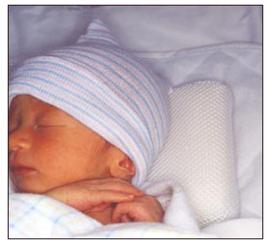
사진 119. 신생아 생리적 황달.
병적 황달이 아니고 생리적으로 생기는 황달을 생리적 황달이라고 한다. 드물게는 생리적 황달과 병적 황달이 함께 있을 수 있다.
Copyright ⓒ 2012 John Sangwon Lee, MD., FAAP
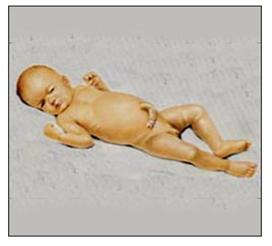
사진 120. Rh 부적합으로 생긴 심한 병적 황달에 걸린 신생아.
Used with permission from Ross Laboratories, Columbus, Ohio 43216, Division of Laboratories, USA 와 소아가정간호백과
- 빌리루빈에는 직접형 빌리루빈(접합형 빌리루빈/Conjugated bilirubin)과 간접형 빌리루빈(비접합형 빌리루빈/Unconjugated bilirubin)이 있고 이 두 가지 형태의 빌리루빈을 합친 빌리루빈을 총 빌비리루빈(Total bilirubin)이라고 한다.
- 자궁 내 태아도 빌리루빈을 계속 만들어진다.
- 태아가 체내에서 만들어진 빌리루빈은 탯줄에 있는 혈관과 태반을 통과해 모체의 혈액 내로 흡수된다.
- 탯줄 혈관과 태반을 통해 모체 내로 들어온 태아의 빌리루빈은 모체 내에서 정상적 신진대사의 과정을 통해 쉽게 처리된다.
- 그 때문에 태어나기 전 태아에게 특별한 병이 생기지 않는 한 태어나기 전 태아는 황달에 걸리지 않는 것이 정상이다.
- 그러나 태어난 순간부터 신생아들은 그들 자신의 체내에서 만들어진 빌리루빈을 신생아들 스스로가 처리해야 한다.
- 그렇지만 출생 후 거의 모든 건강한 만삭 신생아들은 자신들의 체내에서 만들어진 빌리루빈을 초기 신생아기 이후 영유아들과 같이 빌리루빈을 원활하게 처리할 수 있는 생리적 기능이 미약하다.
- 그래서 모든 신생아들은 생후 며칠 동안 어느 정도 생리적 황달에 걸리는 것이 정상적이다.
- 이렇게 생긴 황달을 신생아 생리적 황달 또는 생리적 황달이라고 한다.
- 신생아 생리적 황달이 생기는 과정은 이상 설명한 것같이 단순하지 않고 더 복잡하다.
| 빌리루빈 형성 분비에 관한 구체적 설명. |
- 빌리루빈은 헤모글로불린 혈색소의 일종이다.
- 노쇠 적혈구가 자연적으로 파괴될 때 적혈구 내 헤모글로불린 혈색소에서 빌리루빈이 자연적으로 생성된다.
- 빌리루빈은 직접(형) 빌리루빈과 간접(형) 빌리루빈이 있다.
- 적혈구가 파괴될 때 간접형 빌리루빈이 형성된다.
- 간접형 빌리루빈은 간에서 신진대사 과정을 거쳐 직접형 빌리루빈으로 변화된다.
- 태아 적혈구의 수명은 80~100일 정도이고 출생 이후에 신생아와 골수에서 생성된 적혈구의 수명은 약 100~120일 정도이다.
- 출생 이후 태아 적혈구는 출생 후 짧은 기간 내 다량 파괴되기 시작하고 이 때 상대적으로 신생아 혈 중 간접형 빌리루빈의 혈중 농도가 증가된다.
- 그 간접형 빌리루빈은 간장에서 직접형 빌리루빈으로 원활하게 신진대사되어 담관을 통해 십이지장관 속으로 적절히 분비되는 과정이 정상적으로 느리다.
- 신생아의 간장은 간접형 빌리루빈을 직접형 빌리루빈으로 적절히 그때그때 속히 다 처리할 수 없다.
- 이 때 신생아에게 생리적 황달이 더 잘 생길 수 있다.
- 건강한 만삭 신생아들의 60%, 미숙아 신생아의 80%에서 신생아 생리적 황달이 생긴다.
- 어쩌면 생리적 황달은 정상적인 현상이고 생리적이기 때문에 걱정할 필요가 없는데 우리 소아 청소년과 의사들도 신생아 황달이 생기면 무엇으로 인해 신생아에게 황달이 생겼는지 확실히 알기 전에는 걱정 한다.
- 그 이유는 병적 황달에 관해 잘 알면 쉽게 이해할 수 있다.
- 다시 설명하면, 신생아의 간의 세포가 복잡한 빌리루빈 생화학적 신진대사과정을 통해 간접형 빌리루빈을 직접형 빌리루빈으로 정상적으로 만든다.
- 직접형 빌리루빈은 담즙에 섞여 위장을 통해 십이지장관 내로 분비된다.
- 십이지장관 내과 소장관 내에 있는 간접형 빌리루빈의 일부는 장관 벽 점막층을 통해 다시 혈관 속으로 흡수되는 것이 정상이다.
- 신생아의 간의 세포는 신생아기 이후 영아들이나 성인들의 간세포에 비해서 빌리루빈 신진대사 기능이 미숙하다.
- 노쇠 적혈구들이 정상 이상으로 혈관 내에서 파괴될 때 신생아의 간의 세포는 성인의 간의 세포와 같이 간접형 빌리루빈을 직접형 빌리루빈으로 원활하게 만들어 담관을 통해서 십이지장관 내로 배출시키는 신진대사 기능이 미약하다.
- 따라서 많은 양의 간접형 빌리루빈이 간장에서 혈액 내로 역류되어 들어가게 된다. 이 때 신생아의 간접형 빌리루빈의 혈액 농도가 정상 이상으로 증가된다.
- 혈 중 간접형 빌리루빈의 혈중 농도가 정상 이상보다 더 높을 때 간접형 빌리루빈이 피부 및, 또는 눈의 흰자위 등에 착색 되고 거기가 노랗게 된다.
- 간접형 빌리루빈의 농도가 비정상적으로 상당히 높을 때는 간접형 빌리루빈이 뇌저 신경절에 착색될 수 있고 그로 인해 핵황달이 생길 수 있다.
- 그 밖에 십이지장 관과 소장관 속에 있던 간접형 빌리루빈의 일부는 소장관 벽 점막층을 통해 혈관 속으로 다시 흡수된다.
- 디간딘 등 간세포 효소가 비정상적으로 감소될 때도 혈액 내 간접형 빌리루빈의 농도가 비정상적으로 증가 될 수 있다.
- 요약하면, 혈중 간접형 빌리루빈의 농도가 정상 이상적으로 높아지고 간접형 빌리루빈으로 신생아의 눈 흰자위, 피부 그리고 혈청이 노랗게 되는 생리적 상태를 신생아 생리적 황달 또는 생리적 황달이라고 한다.
- 이와 같이 생리적 황달이 생기는 기전은 복잡하다.
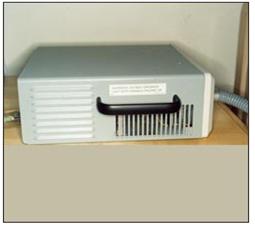
사진 121. 가정에서 치료해도 안전성이 있다고 판단된 경미한 신생아 황달은 가정용 황달 치료 형광 등으로 의사의 지시에 따라 신생아 황달을 치료할 수 있다.
이 기계(좌측 사진)에 신생아 황달 치료를 할 수 있는 황달 치료 형광등이 연결되어 있다.
Copyright ⓒ 2012 John Sangwon Lee, MD., FAAP
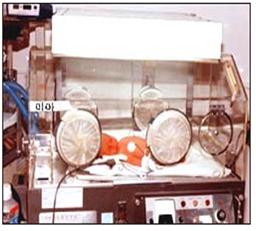
사진 122. 신생아가 황달 치료 형광등으로 신생아 황달 치료를 보육기 속에서 받고 있다.
청색 형광등으로 신생아 황달을 치료할 때 형성 장애성 모반이 생길 수 있다.
Copyright ⓒ 2012 John Sangwon Lee, MD., FAAP
| 신생아 황달과 빌리루빈 바로미터 |
- 만삭에 태어난 건강한 신생아들(만삭아들)의 60%, 미숙아 신생아로 태어난 미숙 신생아(미숙아들)의 80% 가 생리적 황달에 걸릴 수 있다.
- 신생아의 탯줄 혈관의 혈중 간접형 빌리루빈의 정상 혈중 농도는 1.87∼2.8mg/100ml이다.
- 생후 48∼72시간 만삭 신생아의 간접형 빌리루빈 정상 혈중 농도는 5mg/100ml이다.
- 생후 7일 건강한 만삭 신생아의 간접형 빌리루빈 정상 혈중 농도는 2mg/100ml이다.
- 혈중 간접형 빌리루빈은 24시간 동안 5mg/l00ml 이상 증가되면 비정상적이다.
- 신생아의 혈중 간접형 빌리루빈의 농도가 5~6mg/100ml 이상이면 신생아의 피부와 눈 흰자위의 색이 노랗게 되기 시작한다. 황달이 생기면 혈중 간접형 빌리루빈의 농도가 적어도 5~6mg/100ml 이상이라고 추정 할 수 있다.
- 미숙 신생아의 생리적 황달은 생후 7일경 최고에 달하는 것이 일반적이다.
- 생후 28~72시간 된 미숙아의 제대(탯줄) 혈중 간접형 빌리루빈의 농도는 만삭 신생아의 제대 혈중 간접형 빌리루빈의 농도와 거의 같은 것이 보통이다.
- 미숙 신생아의 혈중 간접형 빌리루빈의 농도는 만삭 신생아의 혈중 간접형 빌리루빈의 농도보다 더 높고 더 오랫동안 지속되는 것이 보통이다.
- 미숙 신생아의 간접형 혈중 빌리루빈의 농도는 임신 일수와 각 미숙아에 따라 다를 수 있다.
| 신생아 생리적 황달의 정도는 다음과 같은 여러 가지 조건에 따라 다를 수 있다. |
- 출생 후 모유수유나 인공영양 등을 먹이기 시작한 갓 태어난 아기의 나이
- 신생아가 햇빛에 어느 정도 노출되었는지
- 신생아의 병을 치료할 때 쓰는 약물의 종류에 따라
- 만삭 신생아로 태어났는지 미숙 신생아로 태어났는지 어느 정도 미숙 신생아로 태어났는지
- 앓고 있는 병의 원인과 종류에 따라
- 모유를 먹는지 인공영양을 먹는지에 따라
- 그 외
| 신생아 황달의 증상 징후 |
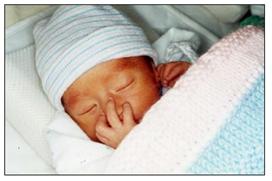
사진 123. 황달로 피부색이 노랗다.
Copyright ⓒ 2012 John Sangwon Lee, MD., FAAP
- 만삭에 태어난 건강한 신생아에게 생긴 생리적 황달은 생후 2~3일에 최고에 달했다가 그 이후부터 간접형 빌리루빈의 혈중 농도가 점차로 감소되기 시작해서 생후 1주경 거의 정상치로 돌아간다.
- 만삭에 태어난 건강한 신생아들의 60% 정도, 임신 37주 이전에 태어난 미숙 신생아들의 80% 정도가 생리적 황달에 걸린다.
- 신생아의 간접형 빌리루빈 혈액 농도가 5~6mg/dl 이상 되면 신생아의 피부와 눈의 흰자위가 노랗게 나타나기 시작한다. 그렇지만 이 때 직접형 빌리루빈 혈중 농도는 거의 정상이고 소변의 색은 정상이다.
- 핵 황달이 생기지 않는 한 생리적 황달이 있을 때 피부나 눈 흰자위가 노란 것 이외 다른 증상 징후는 없다.
- 미숙 신생아의 간세포의 기능은 만삭으로 태어난 정상 신생아의 간세포의 기능보다 더 미숙하다. 때문에 미숙 신생아에게는 생리적 황달이 더 쉽게 생길 수 있고 미숙 신생아에게 생긴 생리적 황달의 정도도 더 심한 것이 통례이다.
- 큰 미숙 신생아들에게 생긴 생리적 황달은 만삭 신생아들에게 생긴 생리적 황달의 정도와 거의 같다. 그러나 아주 작은 미숙 신생아들의 생리적 황달은 생후 곧 나타나기 시작해서 그 후 여러 날을 두고 오랫동안 계속 된다.
- 어떤 경우에는 미숙 신생아들의 생리적 황달은 만삭 신생아들에게 생기는 생리적 황달에 비해서 더 서서히 나타날 수 있고 황달의 정도가 보다 더 심해져서 생후 4~7일경 절정에 달할 수 있다.
| 신생아 생리적 황달의 진단 |
- 대부분의 초산부들은 신생아의 피부나 눈 흰자위가 황달로 노랗게 변한 것을 잘 인식하지 못하고 그냥 지나칠 수 있다.
- 경험이 많은 간호사들이나 의사들은 신생아의 눈 흰자위나 피부의 색이 노란 것을 육안으로 한번 슬쩍 보고 신생아에게 황달이 있는지 쉽게 안다.
- 앞서 설명한 것처럼 신생아 황달의 원인과 종류에는 여러 가지가 있기 때문에 신생아에게 황달이 있으면 신생아 생리적 황달인지 신생아 병적 황달인지 감별 진단해야 한다.
- 신생아의 간접형 빌리루빈 혈중 농도가 20mg/dl 이상이나 그 이상이면 핵황달이 생길 가능성이 있다.
- CBC 피 검사, Rh 인자 검사, 혈액형 검사, 간접형 빌리루빈과 직접형의 빌리루빈 혈 중 농도, 쿰스 검사, 그 밖의 다른 여러 가지 피검사로 신생아에게 생리적 황달이 생겼는지, 또는 다른 원인에 의해서 병적 신생아 황달이 생겼는지 정확하게 진단해야 한다.
- 만삭에 태어난 건강한 신생아에게 신생아 생리적 황달이 생기면 간접형 빌리루빈의 혈 중 농도가 20mg/dl 이상 증가되지 않는 것이 통례이다.
- 그러므로 간접형 빌리루빈의 혈 중 농도가 20mg/dl보다 더 증가되거나 짧은 시간 내에 비정상적으로 간접형 빌리루빈 농도가 계속 증가될 때는 신생아 생리적 황달이 아닐 가능성이 더 많다.
- 신생아 생리적 황달이 있을 때 간접형 빌리루빈의 평균 혈중 농도는 7~15mg/dl 이다.
- 주사로 피를 뽑아 혈중 총 빌리루빈농도를 측정할 수 있고 대신 피부에서 혈 중 총 빌리루빈 농도를 측정 할 수 있는 BliChek이나 JM-103 Jaundice Meter란 빌리루빈 측정기가 있다.
- 필요에 따라 그런 의료 기계로 빌리루빈 농도를 측정할 수 있다.
| 신생아 생리적 황달의 치료 |
- 만삭으로 태어난 건강한 신생아에게 생긴 신생아 생리적 황달의 대부분은 적절하게 양육하는 것 이외 관찰 적 치료를 한다.
- 그러나 미숙아나 어떤 병을 앓는 만삭 신생아에게 생긴 신생아 생리적 황달이 심할 때는 빌리루빈 광선 요법 치료를 한다.
- 황달을 일으킨 원인에 관계없이 간접형 빌리루빈 혈중 농도가 20mg/dl이거나 그 이상 더 올라가지 않도록 치료하는 것이 일반적인 황달 치료 원칙이다.
- 일반적으로 어떤 질병을 앓는 신생아나 탈수된 신생아의 생리적 황달의 정도는 더 심하게 된다.
- 이 때 있는 일차적 병과 탈수를 적절히 치료하면 신생아 황달도 쉽게 치료된다.
Neonatal physiological jaundice

Photo 119. Newborn physiological jaundice. Physiological jaundice that occurs physiologically rather than pathologically is called physiological jaundice. Rarely, physiological jaundice and pathological jaundice may coexist. Copyright ⓒ 2012 John Sangwon Lee, MD., FAAP

Picture 120. Newborn with severe pathological jaundice caused by Rh incompatibility. Used with permission from Ross Laboratories, Columbus, Ohio 43216, Division of Laboratories, USA and Encyclopedia of Pediatric and Family Nursing
• Bilirubin includes direct bilirubin (conjugated bilirubin) and indirect bilirubin (unconjugated bilirubin/unconjugated bilirubin).
• The fetus in the womb continues to make bilirubin.
• Bilirubin produced by the fetus in the body passes through blood vessels in the umbilical cord and the placenta and is absorbed into the mother’s blood.
• Fetal bilirubin, which enters the mother through the umbilical cord blood vessels and placenta, is easily processed in the mother through normal metabolic processes.
• As a result, it is normal for the fetus to not develop jaundice before birth unless the fetus develops a special disease before birth.
• However, from the moment they are born, newborns have to deal with the bilirubin they make in their own bodies.
• However, after birth, almost all healthy full-term newborns have weak physiological ability to process bilirubin as smoothly as in infants after the early neonatal period.
• So it is normal for all newborns to develop some degree of physiological jaundice during the first few days of life.
• This type of jaundice is called neonatal physiological jaundice or physiological jaundice.
• The process of neonatal physiological jaundice is not as simple as described above, but more complex.
A specific description of bilirubin-forming secretion.
• Bilirubin is a type of hemoglobulin.
• Bilirubin is produced naturally from hemoglobulin in red blood cells when senescent red blood cells are destroyed naturally.
• Bilirubin includes direct (type) bilirubin and indirect (type) bilirubin.
• Indirect bilirubin is formed when red blood cells are destroyed.
• Indirect bilirubin is converted into direct bilirubin through metabolism in the liver.
• The lifespan of fetal red blood cells is about 80 to 100 days, and the lifespan of red blood cells produced in newborns and bone marrow after birth is about 100 to 120 days.
• After birth, fetal red blood cells begin to be destroyed in large amounts within a short period of time after birth, and at this time, the blood concentration of indirect bilirubin in the newborn blood is relatively increased.
• The indirect bilirubin is metabolized into direct bilirubin in the liver and properly secreted through the bile duct into the duodenum is normally slow.
• The newborn’s liver cannot properly process indirect bilirubin into direct bilirubin.
• Newborns are more likely to develop physiological jaundice at this time.
• Newborn physiological jaundice develops in 60% of healthy full-term newborns and 80% of premature neonates.
• Maybe physiological jaundice is normal and physiological, so there’s nothing to worry about, but our pediatricians and adolescents do worry when they develop neonatal jaundice until they know for sure what caused it.
• The reason is easy to understand if you know about pathological jaundice.
• In other words, the cells of the newborn’s liver normally convert indirect bilirubin into direct bilirubin through complex bilirubin biochemical metabolism.
• Direct type bilirubin is mixed with bile and secreted into the duodenum through the stomach.
• It is normal for some of the indirect bilirubin in the small intestine to be absorbed back into the blood vessels through the intestinal wall mucosal layer.
• Newborn liver cells are immature in bilirubin metabolism compared to hepatocytes of infants and adults after the neonatal period.
• When senescent red blood cells are destroyed in blood vessels more than normal, the liver cells of newborns have a weak metabolic function that smoothly converts indirect bilirubin into direct bilirubin and discharges it into the duodenum through the bile duct, just like adult liver cells.
• Therefore, a large amount of indirect bilirubin is refluxed into the blood from the liver. At this time, the blood concentration of indirect bilirubin in newborns is increased to more than normal.
• When the blood level of indirect bilirubin in the blood is higher than normal, the indirect bilirubin is colored on the skin and/or the whites of the eyes, and there it turns yellow.
• When the concentration of indirect bilirubin is abnormally and significantly high, indirect bilirubin may stain the basilar ganglia, resulting in nuclear jaundice.
• In addition, some of the indirect bilirubin in the duodenum and small intestine is absorbed back into the blood vessels through the mucosal layer of the wall of the small intestine.
• Even when hepatocyte enzymes are abnormally decreased, the concentration of indirect bilirubin in the blood may be abnormally increased.
• In summary, the physiological condition in which the concentration of indirect bilirubin in the blood is above normal and indirect bilirubin causes the whites of the eyes, skin and serum of newborns to turn yellow is called physiological jaundice or physiological jaundice in newborns.
• The mechanism by which physiological jaundice occurs is complex.

Photo 121. For mild neonatal jaundice that has been judged to be safe to treat at home, neonatal jaundice can be treated with a home jaundice treatment fluorescent lamp according to the doctor’s instructions. A jaundice treatment fluorescent lamp is connected to this machine (pictured left), which can treat neonatal jaundice. Copyright ⓒ 2012 John Sangwon Lee, MD., FAAP

Photo 122. A newborn baby is being treated for neonatal jaundice in an incubator with a fluorescent lamp. Treatment of neonatal jaundice with blue fluorescent lamps may result in nevus dysplasia. Copyright ⓒ 2012 John Sangwon Lee, MD., FAAP
Neonatal Jaundice and Bilirubin Barometer
• Physiological jaundice can occur in 60% of full-term healthy newborns (term babies) and 80% of premature newborns (premature babies).
• The normal blood concentration of indirect bilirubin in the blood vessels of the umbilical cord of newborns is 1.87~2.8mg/100ml.
• Normal blood concentration of indirect bilirubin in full-term newborns 48 to 72 hours after birth is 5 mg/100 ml.
• Normal blood concentration of indirect bilirubin in a healthy full-term newborn 7 days old is 2 mg/100 ml.
• Serum indirect bilirubin is abnormal when it is increased more than 5mg/100ml for 24 hours.
• When the concentration of indirect bilirubin in the blood of a newborn is more than 5~6mg/100ml, the color of the newborn’s skin and whites of eyes begins to turn yellow. When jaundice occurs, it can be estimated that the concentration of indirect bilirubin in the blood is at least 5-6 mg/100 ml.
• Physiological jaundice in premature newborns typically peaks around 7 days of age.
• The concentration of indirect bilirubin in the umbilical cord (umbilical cord) blood of premature infants 28-72 hours after birth is usually about the same as the concentration of indirect bilirubin in the umbilical cord blood of full-term newborns.
• Blood levels of indirect bilirubin in premature neonates are usually higher and longer-lasting than those of full-term neonates
• Concentrations of indirect blood bilirubin in premature neonates depended on the number of days of gestation and each preterm infant.
May vary depending on the degree of neonatal physiological jaundice and may depend on several conditions, including:
1. The age of a newborn baby who started breastfeeding or artificial nutrition after birth
2. How much sunlight was the newborn exposed to?
3. Depending on the type of drug used to treat the disease of the newborn
4. Was born as a full-term or premature newborn, to what extent the newborn was born prematurely
5. Depending on the cause and type of the disease suffered from
6. Depending on whether you are breastfeeding or taking artificial nutrition
7. Others
Signs, symptoms of neonatal jaundice

Photo 123. Yellow skin color with jaundice. Copyright ⓒ 2012 John Sangwon Lee, MD., FAAP
• Physiological jaundice in healthy newborns born at full term peaks on the 2nd or 3rd day after birth, and after that, the blood level of indirect bilirubin starts to gradually decrease and returns to near normal around 1 week after birth.
• About 60% of full-term healthy newborns and 80% of premature newborns born before 37 weeks of gestation develop physiological jaundice.
• When a newborn’s indirect bilirubin blood concentration is 5-6 mg/dl or higher, the newborn’s skin and whites of eyes begin to appear yellow. However, at this time, the blood concentration of direct bilirubin is almost normal and the urine color is normal.
• Unless brain nuclear jaundice develops, there are no symptoms other than yellowing of the skin or whites of the eyes when physiological jaundice is present.
• The function of hepatocytes of premature newborns is more immature than that of normal newborns born at full term. For this reason, it is common for premature newborns to develop physiological jaundice more easily, and the degree of physiological jaundice in premature newborns is more severe.
• Physiological jaundice in large premature newborns is about the same as physiological jaundice in full-term newborns. However, physiological jaundice in very small premature newborns begins soon after birth and continues for many days thereafter.
• In some cases, physiological jaundice in premature newborns may appear more slowly than physiological jaundice in full-term neonates, and the severity of jaundice may be more severe, reaching a peak around 4-7 days of age.
Diagnosis of neonatal physiological jaundice
• Most new mothers are unaware that their newborn’s skin or whites of eyes have turned yellow due to jaundice, and may overlook it.
• Experienced nurses and doctors can easily tell if a newborn has jaundice by looking at the whites of the eyes or the yellow color of the skin of a newborn baby.
• As described above, since there are many causes and types of neonatal jaundice, if a newborn has jaundice, it is necessary to differentially diagnose whether it is neonatal physiological jaundice or neonatal pathological jaundice.
• If the newborn’s indirect bilirubin blood level is 20 mg/dl or higher or higher, there is a possibility of nuclear jaundice.
• CBC blood test, Rh factor test, blood type test, indirect bilirubin and direct bilirubin blood levels, Coombs test, and various other blood tests to determine whether the newborn has physiological jaundice or pathological neonatal jaundice due to other causes It must be accurately diagnosed.
• It is common for indirect bilirubin blood levels to not increase by more than 20 mg/dl when neonatal physiological jaundice occurs in healthy newborns born at full term
• Therefore, when blood levels of indirect bilirubin are increased more than 20 mg/dl, or when the concentration of indirect bilirubin continues to increase abnormally within a short period of time, it is more likely that it is not neonatal physiological jaundice.
• In the presence of physiological jaundice in newborns, the average blood concentration of indirect bilirubin is 7-15 mg/dl.
• BliChek or JM-103 Jaundice Meter is a bilirubin meter that can measure total blood bilirubin concentration by drawing blood by injection and instead measure total blood bilirubin concentration in the skin.
• If necessary, such a medical instrument can measure the bilirubin concentration.
Treatment of neonatal physiological jaundice
• The majority of neonatal physiological jaundice in healthy newborns born to full term require observational treatment other than adequate parenting.
• However, bilirubin phototherapy is recommended for severe neonatal physiological jaundice in premature or full-term newborns with certain diseases.
• Regardless of the cause of jaundice, the general principle of treatment for jaundice is to treat the indirect bilirubin blood level to 20 mg/dl or higher.
• In general, the degree of physiological jaundice is more severe in newborns with certain diseases or in newborns who are dehydrated.
• If the primary disease and dehydration at this time are properly treated, neonatal jaundice is also easily cured.
출처 및 참조문헌
- www.drleepediatrics.com 제1권 소아청소년 응급 의료
- www.drleepediatrics.com 제2권 소아청소년 예방
- www.drleepediatrics.com 제3권 소아청소년 성장 발육 육아
- www.drleepediatrics.com 제4권 모유,모유수유, 이유
- www.drleepediatrics.com 제5권 인공영양, 우유, 이유식, 비타민, 미네랄, 단백질, 탄수화물, 지방
- www.drleepediatrics.com 제6권 신생아 성장 발육 육아 질병
- www.drleepediatrics.com제7권 소아청소년 감염병
- www.drleepediatrics.com제8권 소아청소년 호흡기 질환
- www.drleepediatrics.com제9권 소아청소년 소화기 질환
- www.drleepediatrics.com제10권. 소아청소년 신장 비뇨 생식기 질환
- www.drleepediatrics.com제11권. 소아청소년 심장 혈관계 질환
- www.drleepediatrics.com제12권. 소아청소년 신경 정신 질환, 행동 수면 문제
- www.drleepediatrics.com제13권. 소아청소년 혈액, 림프, 종양 질환
- www.drleepediatrics.com제14권. 소아청소년 내분비, 유전, 염색체, 대사, 희귀병
- www.drleepediatrics.com제15권. 소아청소년 알레르기, 자가 면역질환
- www.drleepediatrics.com제16권. 소아청소년 정형외과 질환
- www.drleepediatrics.com제17권. 소아청소년 피부 질환
- www.drleepediatrics.com제18권. 소아청소년 이비인후(귀 코 인두 후두) 질환
- www.drleepediatrics.com제19권. 소아청소년 안과 (눈)질환
- www.drleepediatrics.com 제20권 소아청소년 이 (치아)질환
- www.drleepediatrics.com 제21권 소아청소년 가정 학교 간호
- www.drleepediatrics.com 제22권 아들 딸 이렇게 사랑해 키우세요
- www.drleepediatrics.com 제23권 사춘기 아이들의 성장 발육 질병
- www.drleepediatrics.com 제24권 소아청소년 성교육
- www.drleepediatrics.com 제25권 임신, 분만, 출산, 신생아 돌보기
- Red book 29th-31st edition 2021
- Nelson Text Book of Pediatrics 19th- 21st Edition
- The Johns Hopkins Hospital, The Harriet Lane Handbook, 22nd edition
- 응급환자관리 정담미디어
-
소아가정간호백과–부모도 반의사가 되어야 한다, 이상원
-
Neonatal Resuscitation American heart Association
-
Neonatology Jeffrey J.Pomerance, C. Joan Richardson
-
Pediatric Resuscitation Pediatric Clinics of North America, Stephen M. Schexnayder, M.D.
-
Pediatric Critical Care, Pediatric Clinics of North America, James P. Orlowski, M.D.
-
Preparation for Birth. Beverly Savage and Dianna Smith
-
Infectious disease of children, Saul Krugman, Samuel L Katz, Ann A. Gershon, Catherine Wilfert
- 소아과학 대한교과서
- Growth and Development of Children, Eighth Edition, George H. Lowrey, Yearbook Medical Publishers
- Growth and Development of Children, Fifth Edition, E. H. Watson and G. H. Lowrey, Yearbook Medical Publishers
- Other
|
Copyright ⓒ 2015 John Sangwon Lee, MD., FAAP 미국 소아과 전문의, 한국 소아청소년과 전문의 이상원 저 “부모도 반의사가 되어야 한다”-내용은 여러분들의 의사로부터 얻은 정보와 진료를 대신할 수 없습니다. “The information contained in this publication should not be used as a substitute for the medical care and advice of your doctor. There may be variations in treatment that your doctor may recommend based on individual facts and circumstances. “Parental education is the best medicine.” |